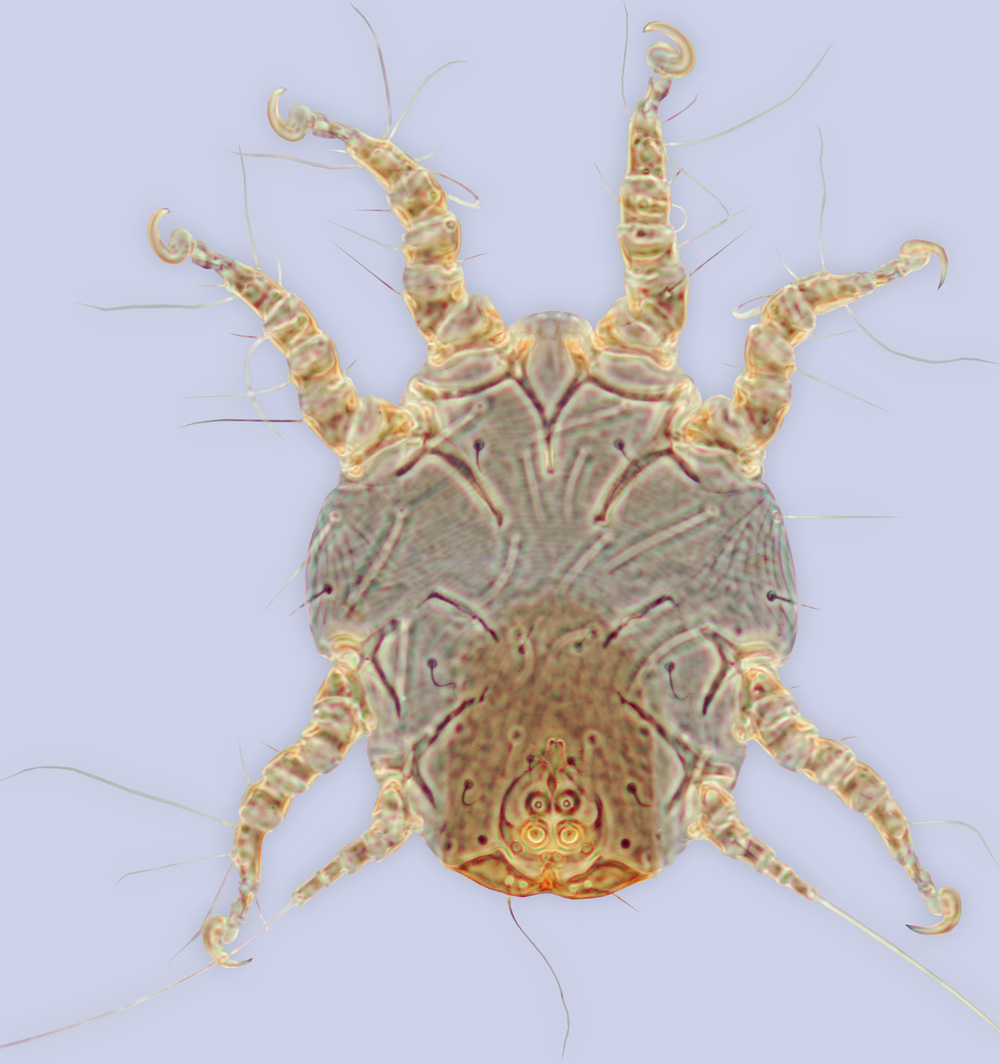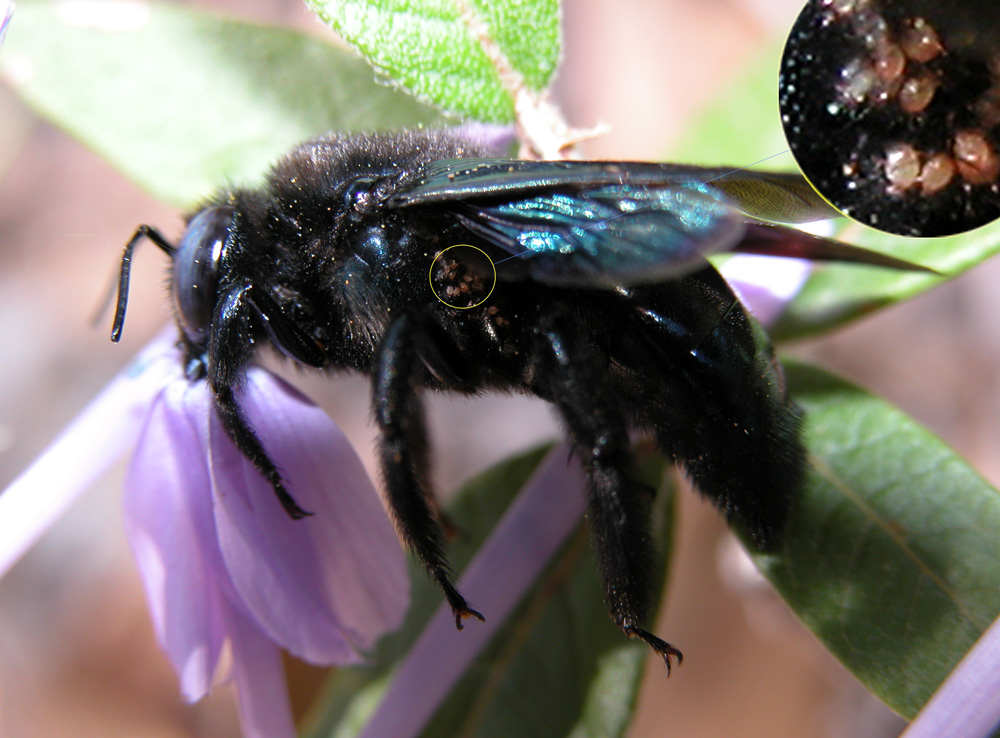Bee Mites : Acari : Acariformes : Sarcoptiformes : Chaetodactylidae : Sennertia : Sennertia species
Sennertia lucrosa Klimov and OConnor, 2008
?Trichodactylus xylocopae (non Donnadieu, 1868): Osborn, 1893: 1021 [California, ex Xylocopa varipuncta (as Xylocopa aeneipennis)].
?Trichotarsus xylocopae (non Donnadieu, 1868): Banks, 1902: 176.
?Trichotarsus xylocopa (non Donnadieu, 1868): Banks, 1902: 176 (lapsus; authorship attributed to Dufour; California, ex Xylocopa)
?Trichotarsus sp. Nininger, 1916: 164 (California, ex Xylocopa varipuncta and Xylocopa tabaniformis orpifex).
Sennertia lucrosa Klimov & OConnor, 2008: 164, Figs 84-85.
Material (show database records). Holotype: 1 HDN – USA: California, Los Angeles Co., Los Angeles, Crenshaw Dist, 14 Apr 1958, V. Reaves, ex male Xylocopa varipuncta (around wing bases), FMNH BMOC 03-0630-038. Paratypes: 11 HDNs - same data as holotype. 16 HDNs (one with pharate tritonymph) – same data, metanotum, 19 Mar 1917, H. Klotz, USNM, BMOC 05-0420-076; 19 HDNs - Ventura Co., Oxnard, San Dunes, Brassica sp (no 651), 16 Apr 1950, R. S. Erdmann, ex X. t. orpifex (1st metasomal tergite), LACM 208288 BMOC 04-1122-019; 16 HDNs - San Diego Co., Escondido, 2 Jan 1934, M. A. Cazier, ex X. t. orpifex (posterior mesosoma), AMNH BMOC 04-0508-322; 21 HDNs - San Diego Co., San Diego, 30 Jun 1937, F.W. Furry, #10, ex X. varipuncta (mesosoma & propodeum), UMMZ BMOC 90-1212-021; 19 HDNs - Orange Co., Santa Ana, 21 Mar 1942, P.D. Hurd, ex X. varipuncta (propodeum), UMMZ BMOC 90-1212-022; 20 HDNs - Los Angeles Co., Los Angeles, Silver Lake Heights [label reads "Silver Lake Hill"], 24 Jul 1933, A.L. Olson, #5, ex X. varipuncta (mesosoma), UMMZ BMOC 90-1212-023; 18 HDNs - Los Angeles Co., Claremont, March 1916, Melville H. Hatch, ex X. varipuncta (1st metasomal tergite), UMMZ BMOC 04-0809-001; 47 HDNs - Los Angeles Co., Los Angeles, Crenshaw Dist, 1 May 1957, V. Reaves, ex X. varipuncta (1st metasomal tergite), FMNH BMOC 03-0630-036; 3 HDNs - San Bernardino Co., 1-7 Apr 1918, J. C. Bradley, ex female X. varipuncta, CUIC HK 84-1217-001; 13 HDNs - Arizona, Santa Cruz Co., Patagonia, 28 June 1953, A. & H. Dietrich, ex female X. californica, CUIC HK 85-0108-002; 1HDNs - Patagonia Mountains, ex X. californica, 1 Jun 1917, Oslar, INHS Insect Collection 62340, BMOC 04-1222-003; 10 HDNs - Santa Cruz Co., Santa Rita Mountains, Madera Canyon, elev. 1523 m, 31°43.37'N 110°52.80'W, 4 Sep 2003, P. Klimov, ex X. californica arizonensis, UMMZ BMOC 03-0904-004; 10 HDNs - Texas, Uvalde Co., Uvalde, 14 Jun 1932, J. O. Martin, ex X. c. arizonensis (posterior wing bases), CAS BMOC 03-0604-037; 13 HDNs - Jeff Davis Co., Davis Mountains, 6 Jul 1936, J. N. Knull, ex X. c. californica (orig: "X. californica oregonensis") (lateral propodeum), OSU OSUC 0121524 BMOC 03-1106-069; 17 HDNs - MEXICO: Baja California, 1 mi NE San Pedro, 8 Sep 1967, J. Chemsak, A. & M. Michelbacher, ex female Xylocopa (pronotum), AMNH BMOC 04-1112-006; 19 HDNs - Baja California Sur, Los Frailes, 18 Mar 1953, P. H. Arnaud, ex X. californica diamesa (propodeum), CAS BMOC 03-0604-040; 36 HDNs - Chiapas, Navenchauc, ex Xylocopa guatemalensis, on lateral propodeum, 2 Apr 1953, R. O. Bechtel & E. I. Sehlinger, USNM, BMOC 05-0420-219; 19 HDNs - Colima, Isla Clarión, ex Xylocopa clarionensis, on propodeum, 7-8 May 1955, McDonald & Blodget, LACM ENT 208588, BMOC 05-0102-024; 10 HDNs – same locality, 27 Apr 1925, H. H. Keifer, ex X. clarionensis (metanotum), CAS BMOC 03-0604-043; 9 HDNs - Morelos, Cuernavaca, 26 Mar 1959, H. E. Evans, ex X. guatemalensis CUIC HK 85-0107-001; 17 HDNs - Puebla, 5 mi SW Chapulco, 5800', ex X. mexicanorum on scutellum, 14 Jul 1970, E. Fisher & P. Sullivan, LACM ENT 208590, BMOC 05-0102-026; 13 HDNs - Sonora, San Francisco Hermosillo, ex Hyptis emoryi (Lamiaceae), ex X. californica arizonensis, over body, 14 Aug 1991, LaBerge, INHS Hymenoptera 8634, BMOC 04-1222-211; 2 HDNs - no locality ex X. guatemalensis on metanotum, no date, C. F. Baker, USNM, BMOC 05-0420-218; 9 HDNs - no locality, ex X. guatemalensis, on propodeum, no date, C. F. Baker, USNM, BMOC 05-0420-220; 2HDNs - no locality, ex X. guatemalensis on propodeum, no date, C. F. Baker, USNM, BMOC 05-0420-221; 2HDNs - no locality, ex X. guatemalensis on propodeum, no date, C. F. Baker, USNM, BMOC 05-0420-222; 27 HDNs - Volcán de Colima, ex X. guatemalensis posterio-lateral mesosoma, 2 Apr 1909, Joh. Laue, USNM, BMOC 05-0420-217. Holotype in FMNH, paratypes in AMNH, CAS, CUIC, FMNH, INHS, LACM, OSAL, UMMZ, UNAM, USNM.
Description. Phoretic deutonymph. Gnathosomal solenidia shorter than 1/3 of femur I width. Supracoxal setae scx situated on separate small sclerite. Hysterosomal shield lateral gland openings and bases of f2 nearly on edge of hysterosomal shield, or the former outside the shield. Lateral edges of hysterosomal shield in anterior part not narrowing. Dorsal hysterosomal pouch absent. Distance between anterior margin of hysterosomal shield and setae si exceeds diameter of si bases. Striate pattern of idiosomal cuticle outside hysterosomal shield without sclerotization, formed by long striae. Distinct rudiments of vi present. Setae si distinctly posterior se; exceed 1/2 of se, almost as thick as se. Diameter of si exceeds 1/2 of diameter of se. Setae c1 subequal to or less than 1. 3 times longer than d1; distinctly longer than h1; long, nearly as long as se; situated anterior to hysterosomal shield. Setae d1 and e1 distinctly longer than h1; d1 situated on hysterosomal shield. Sclerite between ia and d2 absent. Setae e2 subequal with d2; not touching hysterosomal shield. Lateral gland openings situated outside hysterosomal shield. Setae 4b, g, and 4a without distinct rhomb-like widening, filiform. Setae 4b, pR I-II, sR III, wF IV, gT I-II, hT I-II, kT III, ra I-II, and wa I-II filiform. Posterior apodemes II and anterior apodemes III free. Anterior apodemes IV not interrupted, almost straight. Posterior apodeme IV absent. Conoids ps2 posterior to anterior transverse level of central suckers (ad1+2); anterior to ps1, situated outside outer level of ad1+2. Transparent margin of anterior suckers (ad3) without rough sclerotization. Suckers ad3 not enlarged, smaller than central suckers. Posterior and lateral borders of attachment organ not forming distinct frame. Sclerotized rudiment of anterior cuticular suckers absent. Longitudinal hysterosomal sclerite present, short. Ventral hysterosoma smooth. Genual setae mG I-II simple. Genual setae mG II distinctly shorter than leg II, but longer than femur II. Tarsal setae la I-II longer than famulus ε. Tarsal setae ra I-II bifid, blade-like. Tarsal setae wa I-II and s III filiform, needle-like, or widened basally but with attenuated end. Tarsal setae d I-II slightly widened. Tarsal setae d and f I-II almost symmetrical, not touching. Solenidion ω3 closer to f I than to ω1. Posterior condylophore present. Anterior condylophore I-II with distal bending. Seta d III situated close to tarsal base, distance usually subequal or shorter than diameter of d III alveolus. Leg IV protruding posterior edge of hysterosoma. Tarsus IV not enlarged, shorter or less than 2 times longer than width of trochanter IV. Setae w IV thinner than d IV and distinctly shorter than leg IV, situated on middle of tarsus IV. Setae s IV present. Setae wF IV distinctly not reaching base of tarsus IV. Ratio tarsus IV/anterior suckers 1.2-2.1 (1.6±0.19, n=72); ratio tarsus IV/hT II 0.7-1.3 (0.9±0.11, n=72).
Other instars unknown.
Hosts. Xylocopa (Neoxylocopa) varipuncta (type host), Xylocopa (Neoxylocopa) clarionensis, Xylocopa (Neoxylocopa) mexicanorum, Xylocopa (Notoxylocopa) tabaniformis orpifex, Xylocopa (Notoxylocopa) guatemalensis, Xylocopa (Xylocopoides) californica arizonensis, Xylocopa (Xylocopoides) californica, Xylocopa (Xylocopoides) californica diamesa.
Distribution (Show map). USA: Arizona, California (type locality), Texas; Mexico: Baja California, Baja California Sur, Colima, Chiapas, Morelos, Puebla, Sonora.
Biology. This mite species may destroy a small percentage of X. tabaniformis orpifex and X. varipuncta larvae in their nests (Nininger, 1916). Such behavioral features of the bee hosts as use of common surface entrance for several intraspecific or interspecific nest tunnels (X. t. orpifex and X. varipuncta) and consuming provision from adjoining nests by newly emerging bees (X. t. orpifex) (Cruden, 1966; Nininger, 1916) may facilitate mite dispersal.
Etymology. Lucrosus is a Latin adjective (=gainful, profitable).
Notes. Similar to Sennertia faini Baker and Delfinado-Baker, 1983 (see key to species). See also notes below.
We constructed CVA models for S. lucrosa (n=72, all known localities and hosts) and Sennertia faini (n=6, type series). The models including 2-10 log-transformed Darroch and Mosimann shape variables separate the two with 100% accuracy in both analysis and jackknife cross-validation. Ratios created by using raw variables with the highest and the lowest correlation with the canonical function allow for almost complete bivariate discrimination (see key to species above). Sennertia faini is only known from the type series collected from the honey bee from Guatemala. We do not have any mites similar to either S. lucrosa or S. faini s. str. from Central America, so the relationships between the two morphospecies and possible host effect in S. faini cannot be determined. However, the distribution of Xylocopa guatemalensis and the occurrence of S. lucrosa on this host in central Mexico might indicate that the differences of S. faini and S. lucrosa are influenced by host effect of the former, and therefore both belong to the same species.
Correlation of heteromorphic deutonymphs and feeding instars is based on the sharing of the same host species and relative abundance of S. lucrosa deutonymphs.
References
Banks, N. 1902. New genera and species of acarians. The Canadian Entomologist.34: 171-176.
Klimov, P. B. & B. M. OConnor. 2008. Morphology, evolution, and host associations of bee-associated mites of the family Chaetodactylidae (Acari: Astigmata), with a monographic revision of North American taxa. Miscellaneous Publications Museum of Zoology University of Michigan.199: 1-243.
Nininger, H. H. 1916. Studies in the life histories of two carpenter bees of California, with notes on certain parasites. Journal of Entomology and Zoology.8: 159-166.
Osborn, H. 1893. Trichodactylus xylocopae in California. The American Naturalist.27: 1021-1022.
Image Gallery
B. OConnor and P. Klimov ©
Created: May 26, 2011
Last modified: 
